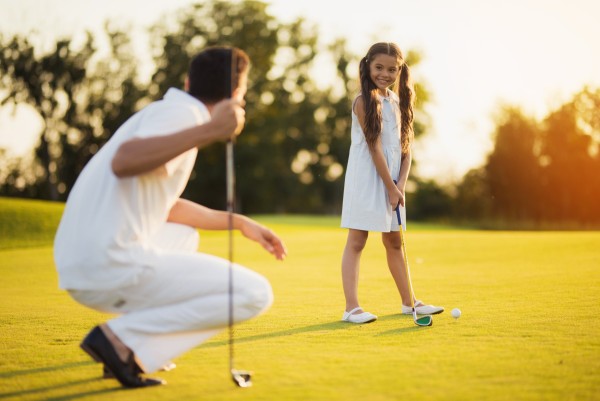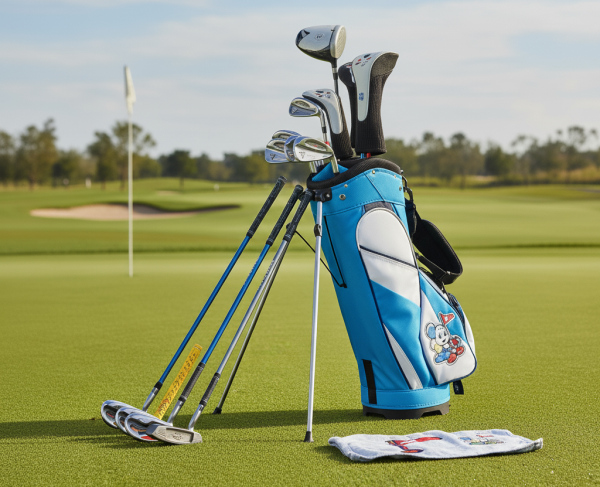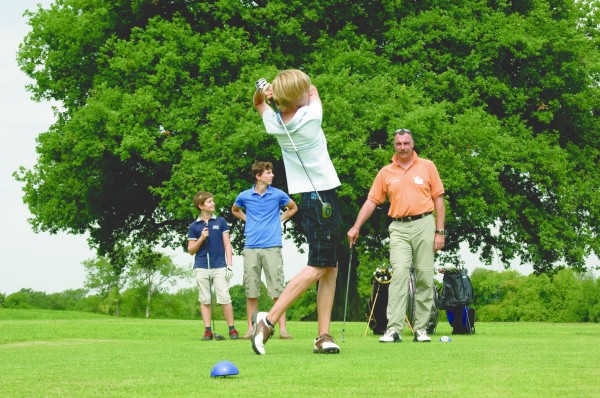Table of Contents
If your child has shown interest in this sport, it is normal that you ask yourself: How to start? What golf exercises for children can help them improve? What are the essential materials for their development? In this guide, we will explain how to teach golf to children, what exercises they can practice according to their level and what materials are essential for them to enjoy and improve their game. We will also explain how golf camps can help young players perfect their technique in a professional and motivating environment.
How to teach golf to children: Tips to get started
Teaching golf to a child may seem complicated at first, but with the right approach, it can become a fun and enriching experience. Here are some key tips to help your child enjoy golf from day one.
Recommended starting age and first steps
Many children start playing golf between the ages of 4 and 6, although there is no exact age. The important thing is that the child has enough coordination to hit the ball and patience to follow instructions.
For the younger ones, the key is to make it playful: instead of focusing on technique from day one, it’s better to turn it into a game where they simply hit the ball and have fun.
To start, you can:
- Give them a light stick and a foam ball to practice with in the yard.
- Create small challenges, such as trying to get the ball into a bucket.
- Get her familiar with basic movements without pressure.

Importance of learning in a group for motivation and progress
Golf may seem like a solitary sport, but learning in a group makes a big difference. When children train with others their age:
- They motivate each other and make golf a social activity.
- They learn to take turns and develop discipline.
- They have more fun, which reduces the chance of them getting bored and dropping out.
If you want your child to stay interested in golf, looking for an academy or group lessons can be a great option. There, in addition to training, they will be able to share experiences with other children and learn in a more dynamic way.
Basic concepts that children should know before they begin
Before your child takes golf more seriously, it is useful for them to understand some essential principles of the game:
- Posture and grip of the club: It doesn’t need to be perfect from the start, but it’s good for them to have a solid foundation.
- Objective of the game: Explain that the purpose is to get the ball in the hole in as few strokes as possible.
- Respect for the course: Teach him to move carefully and follow the basic rules of golf.
With a well-guided, no-pressure introduction, your child can fall in love with golf from day one, and the best part is that he or she will have fun while learning!
Golf drills for kids according to their level
Golf is not just about hitting the ball, it’s about developing accuracy, control and strategy. Each child learns at his or her own pace, so it’s important to choose exercises that are appropriate for his or her level. Here we share with you a series of golf drills for kids that will help them improve their technique while having fun.

Drills for beginners
If your child is taking their first swings, ideally they should start with simple drills that will help them understand how the swing works and the direction of the ball. Here are some options:
- “The straight line”: draw a line on the ground with chalk or lay out a string. The challenge is for the child to hit the ball and keep it as close to the line as possible. This way he learns to control the direction of the hit.
- Balloon Stance and Grip: Inflate a balloon and have the child practice the correct grip on the stick without the balloon falling off. This helps him maintain a relaxed posture and learn to hold the stick without tension.
- Mini targets in the yard: Use buckets or hoops to create mini “holes” and have the child try to put the ball in them with gentle strokes. This improves aim and patience.
Intermediate level exercises
When children already have more control over their strokes, it’s time to work on accuracy and decision making.
- “Hit and Run”: Two children hit the ball from the same spot and, in each turn, they must play from the position where the partner’s ball ended up. This forces them to adjust their stroke according to each other’s play.
- Force control: Use balls of different weights (foam, plastic and real golf balls) so that the child learns to adjust the force of each stroke.
- Golf games for children: Organize small competitions such as “who can get the most balls in the hole with the fewest strokes” or “who can hit a specific area of the course”. Making training a game maintains interest and encourages healthy competition.
Advanced level drills
Children who have already mastered the basics should focus on improving their strategy and getting used to more complex situations on the course.
- Different types of strokes: Place balls on different terrains (high grass, sand, inclines) and have the child practice playing from each one.
- Time limit: Set a specific time to complete a hole. This helps improve decision-making under pressure.
- Tournament simulation: Set up a game with more advanced rules, including stroke count, penalties and rewards. This gives you a more realistic experience and prepares you for future competitions.
With level-appropriate drills, each child can improve progressively and, most importantly, without losing the fun!
Golf supplies for kids: How to choose the best equipment
Having the right equipment is essential for children to play comfortably and without risk of injury.
Not all clubs and accessories work for all ages, so choosing the right equipment can make a big difference in their learning.
Children’s golf clubs
Children’s golf clubs are designed to be lighter and more maneuverable than adult clubs. They usually come in sets according to the age and height of the child.
- Initiation clubs (3-5 years old): They are ultra-light and allow for effortless basic shots.
- Intermediate sticks (6-10 years old): They are more resistant and help to perfect the technique.
- Advanced clubs (11-16 years old): They are more similar to those for adults, but with weight and size adjustments.
Opting for slightly longer clubs can be useful, as children grow fast, but they should never be excessively large because it will affect their technique.

Children’s golf shoes
Footwear is key to avoid slipping and ensure good balance on every shot. Children’s golf shoes should:
- Have a sole with good grip for stability on uneven terrain.
- Be comfortable and flexible to allow natural movement.
- Offer ankle support to prevent injury.
If your child is just starting out, they can wear sneakers with good grip, but if they train regularly, it is advisable to invest in specific golf shoes.

Essential accessories
In addition to clubs and shoes, there are other accessories that can enhance the playing experience for children:
- Golf gloves: They improve grip and prevent hand blisters.
- Caps and breathable clothing: They help protect them from the sun and keep them cool on the course.
- Adapted tees: They are taller and easier for young children to use.
Proper equipment not only facilitates learning, but also makes children enjoy golf more without worries.

Golf camps: an opportunity to improve
If your child already plays golf and wants to improve his or her skills, a summer golf camp can be one of the best experiences.
These specialized camps offer much more than intensive training. In addition to improving technique, they help young players develop strategic skills and strengthen their competitive mindset. All this in a motivating environment where learning and fun go hand in hand.
why are golf camps a good option?
A golf camp is more than just lessons. It is a complete immersion in the world of golf, with professional coaches, access to high-level facilities and a comprehensive approach to player development.
Some of the advantages of these programs include:
- Expert coaching: Kids learn from coaches with high-performance experience.
- Competitive and motivating environment: Sharing with other players boosts their athletic growth.
- Advanced technical analysis: Some camps use technology to evaluate and improve swing, stance and game strategy.
- Teaching sports values: Discipline, decision-making and concentration, essential for golf, are reinforced.
Golf camps in Spain and abroad
Spain has excellent programs for young golfers, but there are also prestigious international academies where players can train in top-level professional environments.
Depending on the level and goals of the child, parents can opt for national programs or experiences abroad that combine sports training with personal growth.
If you’re looking for a camp where your child can improve their golf while having fun and growing as a player, there are options designed to enhance their talent in a professional environment. Ertheo’s golf camps are an excellent alternative for children and teens looking to perfect their technique and enjoy golf in a high-performance environment.

Frequently asked questions about children’s golf
Here we answer some of the most common questions that may arise about children’s golf learning and development.
what is the best age to start playing golf?
There is no exact age, but many children start between the ages of 4 and 6, when they already have some coordination and can hold a club with ease. At that age, the ideal is for them to practice through play, without pressure or formal training.
how many hours of practice per week are recommended for a child?
It depends on the child’s level and goals. For beginners, 1 or 2 one-hour sessions per week may be sufficient. For more advanced children who compete, we recommend 4 to 6 hours per week, combining practice on the field and specific training sessions.
is it necessary to federate a child to play golf?
Not always. Although federation is mandatory to participate in tournaments and access certain courses, many clubs allow children to play and train without federation.
However, having a federation license from the Royal Spanish Golf Federation (RFEG) offers advantages such as sports insurance and access to more official competitions. This facilitates the player’s development in a more professional environment.
how to find a suitable golf academy?
The most advisable is to look for an academy with certified coaches and groups of children of the same level, where both the technique and the mental development of the player are worked on. It is also important that the academy offers adequate facilities and a progressive training plan.
how long does it take to learn to play golf?
The time varies according to the frequency of practice and the natural talent of the child. With regular practice, a beginner can develop a solid game in 6 months to a year. However, perfecting technique and playing at a competitive level can take several years.
Conclusion: A Great Sport for a Great Future
Golf is not just a sport, it is an opportunity for children to develop discipline, focus and confidence. With the right drills and the right equipment, they can improve their technique while enjoying the game. Beyond the course, they learn valuable skills that will accompany them as they grow.
If your child wants to advance in golf, it’s key to surround them with the best opportunities. Ertheo‘ s camps allow them to train with professionals, live with other young golfers and live a unique experience in a high-level environment.
want to learn more about our golf camps and how they can help your child improve his or her game? Contact us and we will give you all the information you need.


